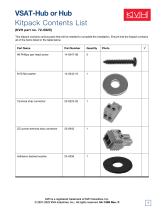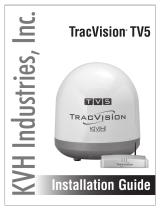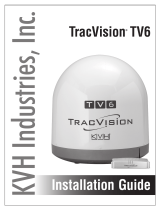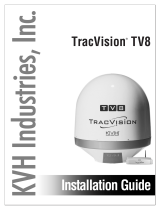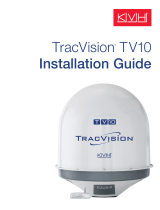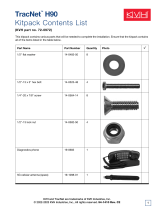Page is loading ...

TracVision M9 Installation Guide
TracVision M9
Standard Configuration

TracVision M9 Installation Guide
1
Standard Configuration with Master Control Unit (MCU)
KVH, TracVision, and the unique light-colored dome with contrasting baseplate are registered trademarks of KVH Industries, Inc.
All other trademarks are property of their respective companies. The information in this document is subject to change without notice.
No company shall be liable for errors contained herein. © 2007 KVH Industries, Inc., All rights reserved. 54-0418 Rev. C
These instructions explain how to install the TracVision M9 satellite TV antenna system on a
vessel. Complete instructions on how to use the system are provided in the User’s Guide.
Installation Steps
Who Should Install the System?
To ensure a safe and effective installation, KVH recommends that a KVH-authorized marine
technician install the TracVision antenna. KVH-authorized technicians have the tools and
electronics expertise necessary to install the system. To find a technician near you, visit
www.kvh.com/wheretogetservice.
Antenna LNB Types
The installation process differs slightly depending on the type of LNB (low noise block) that is
installed in the antenna (circular or linear). These differences are noted throughout this manual.
Appendix C on page 25 notes the type of LNB required for each region and satellite.
Technical Support
If you need technical assistance, please contact KVH Technical Support:
1. Inspect Parts and Get Tools...3
2. Plan the Antenna Installation...4
3. Plan the MCU Installation...5
4. Prepare the Antenna Site...6
5. Wire the Antenna...7
6. Mount the Antenna...8
7. Remove the Restraints...9
8. Wire the Receiver(s) and MCU...10
9. Connect Power...11
10. Mount the MCU...12
11. Select Satellites...13
12. Calibrate the Internal Sensor...14
13. Educate the Customer...16
North/South America, Australia:
Phone: +1 401 847-3327
E-mail: [email protected]
Europe, Middle East, Asia:
Phone: +45 45 160 180
E-mail: [email protected]

3
Before you begin, follow these steps to make sure
you have everything you need to complete the
installation.
a. Unpack the box and ensure it contains
everything shown on the Kitpack Contents
List. Save the packaging for future use.
b. Carefully examine all of the supplied parts to
ensure nothing was damaged in shipment.
c. Gather all of the tools and materials listed
below. You will need these items to complete
the installation.
• Flat-head and Phillips-head screwdrivers
• Electric drill and 1/2" (13 mm) and #29
drill bits
•17 mm socket wrench
• 9/16" open-end wrench
• Light hammer and center punch
•Adhesive tape
• Scriber or pencil
• Wire strippers
• 15-amp quick-tripping circuit breaker
• RG-6 or RG-11 RF coax cable(s) with
Snap-N-Seal
®
F-connectors for
connecting the antenna to the receiver(s)
(see Step 4e on page 6 to determine the
number and type of cables required)
• Connector installation tool (Augat IT1000
- KVH part #19-0242)
• Power cable for connecting vessel power
to the MCU (see Figure 2)
• Satellite TV receiver and TV
Radome
Baseplate
Connectors
Figure 1: TracVision M9 System Components
(w/Logo Plate)
Antenna
MCU (Master Control Unit)
Display
Buttons
Always lift the antenna by the baseplate and
never by the radome or any portion of the
internal antenna assembly (see Figure 1).
IMPORTANT!
Figure 2: Power Cable Guidelines
Cable Length Use Cable Gauge
< 40 ft (12 m)
12AWG (4mm
2
)
40-70 ft (12-21 m)
10AWG (6mm
2
)
Inspect Parts and Get Tools
1

4
Before you begin, consider the following antenna
installation guidelines:
• Minimize blockage. The antenna requires a
clear view of the sky to receive satellite TV
(see Figure 3). The fewer obstructions, the
better the system will perform.
• Make sure the mounting surface is wide
enough to accommodate the antenna’s base
(see Figure 4). Also make sure it is flat, level,
strong enough to support the antenna’s
weight (85 lbs, 38.6 kg), and rigid enough to
withstand vibration.
• Be sure to preserve enough free space outside
the access hatch to allow a technician to
remove the hatch and perform maintenance.
• Select a location that is as close as possible to
the intersection of the vessel’s fore-and-aft
centerline and midships.
• Select a location that is not too high above the
waterline. Limit the height above the
waterline to less than 1/2 the vessel’s length.
• Do not mount the antenna at the same level
as the radar because the radar’s energy might
overload the antenna. Ideally, you should
mount the antenna 4 ft (1.2 m) above and 4 ft
(1.2 m) away from the radar.
• Select a location that is at least 4 ft (1.2 m)
away from any magnetized materials, large
ferrous masses, cranes, engines, derricks,
other antennas, devices with DC motors,
electric winches, high-amperage cables, or
battery banks. The antenna’s internal
compass sensor performs best in a benign
magnetic environment.
• If you are mounting the antenna on a steel
vessel, use an aluminum, brass, plastic, or
wood platform (NOT steel or iron) to position
the antenna at least 4 ft (1.2 m) above and 6 ft
(1.8 m) away from the steel surface.
Blocked!
Antenna
Vessel Platform
Mast
Look angle
Figure 3: Blockage from Obstruction
FWD
38.86"
(98.7 cm)
4x ø.50"
(4x ø13 mm)
ø35"
(ø88.9 cm)
12"
(30.5 cm)
6"
(15.2 cm)
6"
(15.2 cm)
12"
(30.5 cm)
Access Hatch
17"
(43.2 cm)
Figure 4: Antenna Dimensions
Side View
Bottom View
Plan the Antenna Installation
2

5
Before you begin, consider the following MCU
installation guidelines:
• Select an MCU mounting location in a dry,
well-ventilated area belowdecks away from
any heat sources or salt spray.
• Be sure the MCU’s front panel will be easily
accessible to the user. The owner will use the
MCU’s buttons to control the antenna.
• Be sure to leave enough room at the MCU’s
rear panel for connecting the cables (see
Figure 5 for MCU dimensions).
• Since the supplied data/power cable is 100 ft
(30 m) long, the MCU should be located
within 100 ft (30 m) of the antenna.
• The kitpack contains parts for mounting the
MCU either to a horizontal surface (using
Velcro) or to a vertical surface (using the
supplied flush mount bracket).
Prepare the MCU Mounting Site
(Flush Mount only)
NOTE: Skip this step if you plan to mount the MCU
to a horizontal surface instead.
a. Using the MCU flush mounting template
provided at the end of this manual, mark and
cut out a hole in the mounting surface to
accommodate the flush mount bracket (see
Figure 6).
b. Using the same template, mark the locations
for the four MCU mounting holes.
c. Using a #29 drill bit, drill a 0.136" (3.45 mm)
hole at the four mounting hole locations.
Later, you will mount the MCU using four #8
screws.
2.52"
(64.1 mm)
8.1"
(205.7 mm)
9.18"
(233.2 mm)
0.66"
(16.7 mm)
Figure 5: MCU Dimensions
Front View
Top View
8.87"
(225 mm)
7.62"
(194 mm)
.63"
(16 mm)
3.08"
(78 mm)
1.83"
(46 mm)
.63"
(16 mm)
.136" ( 3.45 mm)
Mounting Hole (x4)
Figure 6: MCU Mounting Holes Layout
Plan the MCU Installation
3

6
Once you have identified a suitable antenna
mounting site, according to the guidelines
provided in Step 2, follow these steps to drill the
mounting holes and cable access hole to prepare
the site for installation.
a. Unfold the antenna mounting template
(supplied in the Customer Welcome Kit) and
place it onto the mounting surface. Make sure
the “FWD” (forward) arrow points toward
the bow and is parallel to the vessel’s
centerline (see Figure 7).
NOTE: You don’t need to mount the antenna
exactly on the vessel’s centerline, but the
antenna’s forward arrow must be parallel to it.
b. Use the template to mark the locations for the
four mounting holes on the mounting
surface.
c. Drill a 1/2" (13 mm) hole at the four
mounting hole locations you marked in
Step 4b. Later, you will insert four M10 bolts
from below to secure the antenna to the
mounting surface.
d. Mark a location for the cable access hole,
either in the center of the antenna mounting
hole pattern or in an area aft of the antenna.
Later, you will route the data/power and RF
cables through this hole and into the vessel.
e. Drill the cable access hole in the location you
marked in Step 4d. Be sure to size the hole
appropriately to accommodate the data/
power cable and all required RF cables (see
Figure 8 and Figure 9 to determine the
number and type of RF cables required).
Smooth the edges of the hole to protect the
cables.
Figure 7: Antenna Mounting Holes Layout
If you wish to route the cables through the
bottom of the antenna’s baseplate, rather than
connecting at the side, you will need to
modify the antenna’s baseplate. See
Appendix A on page 19 for details.
IMPORTANT!
Figure 8: Number of RF Coax Cables Required
* Multiswitch required for 3 or more receivers.
** Multiswitch required for 5 or more receivers.
See Appendix B on page 23 for details.
Connecting to: # RF Cables
System with Dual LNB
1 receiver 1
2 or more receivers 2*
System with Quad LNB (Europe Only)
1 receiver 1
2 receivers 2
3 receivers 3
4 or more receivers 4**
Figure 9: RF Cable Guidelines
Cable Length Use Cable Type
≤ 75 ft (23 m) RG-6
> 75 ft (23 m) RG-11
Prepare the Antenna Site
4

7
Follow these steps to connect the data/power
and RF cables to the antenna.
a. Route the data/power and RF cables
belowdecks through the cable access hole.
Leave an adequate service loop,
approximately 8" (20 cm) of slack, in the
cables for easy serviceability. Later, you will
connect the data/power cable to the MCU
and the RF cable(s) to the receiver(s).
b. Position the antenna in place over the
mounting holes with the baseplate’s
connectors (see Figure 10) facing the stern.
c. Connect the data/power cable to the antenna
(see Figure 11 and Figure 12); hand-tighten.
d. Using a 9/16" wrench, connect the RF cable(s)
to the antenna. If you need to connect only
one RF cable, connect the cable to the
antenna’s RF1 connector (see Figure 12).
Connect any additional RF cables to the RF2,
RF3, and RF4 connectors.
TIP: If you connect two or more RF cables, label
both ends of each cable to match the connector.
This will make it easier to identify the cables later.
e. Place the rear logo plate over the cables, so
each cable exits the proper opening (see
Figure 13). Using six M4 screws, attach the
logo plate to the baseplate.
If you wish to route the cables through the
bottom of the antenna’s baseplate, rather than
connecting at the side, see Appendix A on
page 19 for supplemental instructions.
IMPORTANT!
Figure 10: Antenna Connectors
Connectors
F-type Connector N-type Connector
MCU Antenna
Figure 11: Data/Power Cable Connections
Be sure to properly align the data/power
cable with the antenna’s baseplate connector
before tightening. Connecting the cable at an
angle may damage the cable’s center tines.
IMPORTANT!
Figure 12: Antenna Baseplate Cable Connections
RF3 RF1 RF2 RF4
Data/
Power
Figure 13: Rear Logo Plate Installed
M4 Screw (x6)
RF1 Cable Data/Power Cable
Wire the Antenna
5

8
Follow these steps to mount the antenna to the
mounting surface.
a. Place the antenna baseplate over the holes
drilled in the mounting surface.
b. Make sure the four holes in the baseplate line
up with the four holes in the mounting
surface. Also make sure the connectors face
the stern.
c. At each of the four baseplate mounting holes,
place an M10 lock washer and flat washer on
an M10 bolt and insert the bolt into the hole
from below (see Figure 14).
d. Tighten all four bolts until the four rubber
feet are bottomed against the mounting
surface.
M10 x 50 mm Bolt (x4)
Antenna Base
Mount Surface
M10 Flat Washer (x4)
M10 Lock Washer (x4)
10 mm max.
Figure 14: Mounting the Antenna (Side View)
Make sure the mounting screws do not
extend further than 0.4" (10 mm) into the
antenna’s baseplate. Inserting the screws any
further will damage the antenna.
IMPORTANT!
Do not block the four small drain holes in the
bottom of the antenna. These drain holes
ensure that any moisture within the antenna
will be able to escape.
IMPORTANT!
Mount the Antenna
6

9
Inside the antenna, three heavy-duty tie-wraps
prevent the antenna assembly from moving
during shipment. Follow these steps to remove
these shipping restraints.
a. Remove the eight #10-32 Phillips-head screws
securing the radome to the baseplate (see
Figure 15). Carefully lift the radome straight
up until clear of the antenna assembly and set
it aside in a safe place.
TIP: If you keep the radome topside, secure it with
a lanyard to prevent it from falling overboard.
b. Unfasten the two tie-wraps securing the
reflector to the antenna frame (see Figure 16).
To unfasten the tie-wraps, release the tab
with a flat-head screwdriver.
c. Unfasten the tie-wrap securing the antenna
frame to the sensor bracket (see Figure 17).
d. Save the tie-wraps for future use; the
customer will need to reinstall them if he/she
needs to relocate or reship the antenna.
e. Reinstall the radome onto the antenna. Secure
in place with the eight #10-32 screws you
removed in Step 7a.
f. Install a protective plastic screw cap
(supplied in the kitpack) over each radome
screw.
#10-32 Screw (x8)
Figure 15: Removing the Radome
Figure 16: Locations of Shipping Restraints
Tie-wrapTie-wrap
Tie-wrap
Figure 17: Close-up of Antenna Frame Shipping Restraint
Tie-wrapSensor Bracket Frame
Remove the Restraints
7

10
Follow these steps to connect the antenna to the
belowdecks equipment.
NOTE: System wiring diagrams are provided in
Appendix F on page 31.
a. If you are connecting two receivers to the
TracVision system, decide which receiver
will be the primary receiver. The primary
receiver controls satellite selection.
NOTE: The secondary receiver will only be able to
select a channel carried on the satellite that is
currently selected on the primary receiver.
b. Connect the RF1 cable from the antenna to
the “Satellite In” jack on the primary receiver
(see Figure 18).
c. If you are connecting two receivers, connect
the RF2 cable from the antenna to the
“Satellite In” jack on the secondary receiver.
d. Connect the receiver(s) to the customer’s
television(s). Follow the instructions in the
receiver’s manual.
e. Connect the data/power cable from the
antenna to the “Output to Antenna” jack on
the MCU (see Figure 19). Do not overtighten
the connection; finger-tight is sufficient.
If you wish to connect three or more receivers
to the antenna, see Appendix B on page 23.
IMPORTANT!
Primary Receiver
(controls satellite selection
)
SATELLITE IN
OUT TO TV
TV ANT/CABLE IN
AUDIO VIDEO S-VIDEO PHONE JACK
RL
SATELLITE IN
Secondary Receiver - Optional
SATELLITE IN
OUT TO TV
TV ANT/CABLE IN
AUDIO VIDEO S-VIDEO PHONE JACK
RL
SATELLITE IN
RF1
RF2
MCU
Data/Power
Antenna
Gnd To MCU
DC Return (-)
Gnd To MCU
DC Return (-)
Figure 18: Receiver Wiring
Be sure all receivers are grounded properly.
Connect a ground wire from the chassis of
each receiver to the MCU’s DC return. This
will ensure all system grounds are the same
potential.
IMPORTANT!
Figure 19: MCU Rear Panel
Output to Antenna
Wire the Receiver(s) and MCU
8

11
Follow these steps to connect power to the MCU.
The MCU supplies power to the antenna.
a. Before you begin, disconnect vessel power.
b. Connect a power cable to 24 VDC (2.5 amps)
vessel power (for cable specifications, see
Figure 2 on page 3).
Power supplied to the
antenna MUST NOT fall below 18 VDC or
exceed 30 VDC.
NOTE: If a 24 VDC power supply is not available,
install an AC/DC converter that supplies 24 VDC
(KVH part #19-0488 or equivalent).
c. KVH recommends you install a 15-amp
circuit breaker between power and the MCU.
The MCU does not have an on/off switch.
d. Install the ferrite coil, supplied in the kitpack,
onto your vessel power cable to help reduce
conducted emissions. Make two loops in the
cable and clamp the coil around the loops
(see Figure 20). This ferrite coil must be
installed to comply with the CE standard.
e. Find the plastic power plug supplied in the
kitpack (see Figure 21). Insert your vessel
power wires into the plug’s power (+) and
ground (-) terminals. Tighten the plug’s
terminal screws to secure the wires in place.
f. Plug the power connector plug into the
“Power In” jack on the MCU. Secure in place
with the two retaining screws.
g. Connect the MCU ground wire (see
Figure 22) to a suitable ground point.
CAUTION
For your own safety, disconnect vessel power
and make sure the circuit is dead before you
connect any power wires.
Figure 20: Ferrite Coil Clamped onto Power Cable
Ferrite Coil
Figure 21: Power Plug
Terminal Screw (x2)
GroundPower
Retaining Screw (x2)
Figure 22: MCU Power Connection
MCU Ground Wire
Power In
Connect Power
9

12
In Step 3, you identified a suitable MCU
mounting location. Now follow these steps to
mount the MCU using one of the following
options:
Option 1 - Velcro mount to a horizontal surface
Option 2 - Flush mount to a vertical surface
Option 1 - Velcro Mount
a. Clean the bottom of the MCU and the
mounting surface using a mild detergent.
b. Peel the backing from the four supplied
Velcro fabric squares and stick them to the
bottom corners of the MCU (see Figure 23).
c. Position the four Velcro hook disks onto the
mounting surface. Drill screw holes for the
disks and secure in place with #4-24 screws.
d. Press the MCU firmly into place so the
fabric’s loop material engages the hook disks.
Option 2 - Flush Mount
a. At the two holes in the bottom of the MCU,
place a #6 flat washer on a #6-32 screw and
insert the screw from below (see Figure 24).
Do not tighten the screws yet.
b. Slide the flush mount bracket backward onto
the MCU until the two notches in the bracket
engage the screws at the bottom of the MCU.
c. Tighten the screws to secure the bracket to
the MCU.
d. In Step 3 on page 5, you cut out the mounting
hole in the mounting surface. Insert the MCU
and bracket assembly into this mounting hole
and secure in place with four #8 screws and
washers (see Figure 25).
Fabric Strip (x4)
Hook Disk (x4)
#4-24 Screw (x4)
Figure 23: Velcro Mounting
#6-32 x 1/2" Screw
and Washer (x2)
Figure 24: Flush Mount Bracket
#8 Screws and
Washers (x4)
Figure 25: Flush Mounting the MCU to a Vertical Surface
Mount the MCU
10

13
Follow these steps to turn on the system and set it
up for the desired pair of satellites.
a. Ensure the antenna has a clear, unobstructed
view of the sky.
b. Apply power to the receiver(s), TV(s), and
MCU. Wait two minutes for system startup.
c. Press the center MENU button on the MCU
to access the onscreen menu (see Figure 26).
d. At “Install Satellite?”, press YES.
e. At “Install A <SAT NAME>”, press NEXT
until the display shows the first (primary)
satellite you want to select. Then press YES.
(See Appendix C on page 25 for a list of
available satellites.)
NOTE: If you don’t find the satellite you want,
you can set up a user-defined satellite (USER 1 or
USER 2). See Appendix D on page 26.
f. Repeat Step 11e to select the second satellite.
If you want to set up the antenna to track just
one satellite, select “None” instead.
g. At “Restart Antenna?”, press YES. Wait two
minutes while the antenna restarts.
h. (Linear systems only) Set up the receiver(s)
for the same satellites, and in the same order,
that you set them up in the antenna:
Antenna Receiver DiSEqC
Sat. A Alternative 1 or A DiSEqC 1
Sat. B Alternative 2 or B DiSEqC 2
Install Satellite?
Yes Next Return
Install A <SAT NAME>
Yes Next Cancel
Menu
<SAT NAME1> and
<SAT NAME2> installed
Press NEXT until desired satellite shown
Install B <SAT NAME>
Yes Next Cancel
Installing sats
Please wait
Press NEXT Until desired satellite shown
Restart antenna?
Yes No
Figure 26: Satellite Selection Menus on MCU
Select Satellites
11

14
The antenna’s internal compass sensor is
calibrated at the factory for a perfect-world
environment. However, hard and soft iron effects
on your vessel can distort the magnetic field
around the antenna, causing errors in the
sensor’s reported heading. To compensate for
these magnetic distortions, follow these steps to
calibrate the internal sensor.
Turn On Autocalibration
Follow these steps to turn on the system’s
Autocalibration function. The Autocalibration
function will allow the sensor to calibrate itself
automatically.
a. Press the center MENU button on the MCU
to access the onscreen menu (see Figure 27).
b. At “Install Satellite?”, press NEXT until the
display shows “Operations Mode?” Then
press YES.
c. At “Get Antenna Status?”, press NEXT until
the display shows “Control Compass?” Then
press YES.
d. At “Set Autocal on/off?”, press YES.
e. At “Autocal is: OFF”, press ON.
f. At “Autocal is: ON”, press RETURN.
Run the Autocalibration Function
Follow these steps to steer the vessel through a
complete circle to ensure the Autocalibration
function effectively calibrates the sensor.
NOTE: If the antenna is installed on a large vessel,
such as a tanker or cargo ship, you may omit this step.
Simply leave the Autocalibration function set to ON.
a. Select a calm day and navigate the vessel to a
clear area. Excessive pitching and rolling can
distort calibration data.
b. Apply power to the TracVision system.
c. Just before you begin, note the vessel’s
heading.
Install Satellite?
Yes Next Return
Control compass?
Yes Next Return
Menu
Set Autocal on/off?
Yes Next Return
Autocal is: OFF
On Return Off
Until “Operations Mode” shown
Autocal is: ON
On Return Off
Operations Mode?
Yes Next Return
Get Antenna Status?
Yes Next Return
Until “Control Compass” shown
Figure 27: Turning On Autocalibration at the MCU
Calibrate the Internal Sensor
12

15
d. Steer the vessel at a slow, steady speed
through a complete circle that takes at least
two minutes to complete (see Figure 28). Use
the heading you noted in Step c to confirm
when you have completed a full circle.
Check the Calibration Score
Once you have completed the circle, follow these
steps to check the calibration “score.”
a. Press the center MENU button on the MCU
to access the onscreen menu.
b. At “Install Satellite?”, press NEXT until the
display shows “Operations Mode?” Then
press YES.
c. At “Get Antenna Status?”, press NEXT until
the display shows “Control Compass?” Then
press YES.
d. At “Set Autocal on/off?”, press NEXT until
the display shows “Get Cal Score?” Then
press YES.
e. The display shows the score for the
calibration you performed (see Figure 29).
f. If Accuracy = “BAD CAL”:
Recalibrate the sensor by navigating through
an additional circle. Repeat until you achieve
a suitable accuracy rating.
g. If Mag. Environment = “POOR” or “BAD”:
Check the area around the antenna for
materials that might cause magnetic
interference. Relocate the materials, if
possible, or relocate the antenna to a more
favorable magnetic environment (see Step 2
on page 4 for details). Then clear the
calibration score (see Appendix E on page 30)
and recalibrate the sensor.
h. Press any button. The display returns to the
“Get Cal score?” screen.
i. Press RETURN until you exit the menu.
NOTE: The Autocalibration function turns off
automatically once the system achieves a good
calibration score.
30 Seconds
1 Minute
1 Minute,
30 Seconds
2 Minutes
Figure 28: Running Autocalibration
ACC MagEnv Cal#
CAL<1° GOOD 1
Accuracy
Rating
Calibration
Number
Magnetic
Environment
Figure 29: Calibration Score Example
Data Field Description
Accuracy
Rating
Degree of accuracy the
sensor will provide
(CAL<1º = within 1º)
Magnetic
Environment
Quality of the antenna’s
installation site
Calibration
Number
Number of times the
sensor was calibrated
Continued...
12

16
The installation process is complete!
Before you depart the vessel, test the system to
verify the antenna works properly. Then give the
Customer Welcome Kit to the customer and
explain how to use the system. Also be sure the
customer understands the following:
• Keep the radome installed on the antenna at
all times. The radome protects the antenna’s
moving parts from wind, rain, and debris.
• The antenna must have a clear view of the
sky to receive satellite TV. Common causes of
blockage include trees, buildings, bridges,
and onboard equipment (see Figure 30).
• Heavy rain or snow may temporarily
interrupt reception.
• Clean the antenna regularly. Dirt buildup on
the radome can affect reception.
• The vessel must be located within the
selected satellite’s coverage area to receive its
satellite TV signals. To view satellite coverage
maps, visit www.kvh.com/footprint.
• Please register the system with KVH. The
registration process is quick, easy, online, and
ensures the best possible service from KVH.
Visit www.kvh.com/register or refer to the
Product Registration Form for details.
• Refer to the User’s Guide for complete
operation instructions and troubleshooting
information.
WARNING
It is dangerous to watch TV while piloting a
vessel. The TracVision system is intended as
a passenger entertainment product only.
TracVision
Figure 30: Example of Satellite Blockage
Educate the Customer
13

Appendices
17
This section provides supplemental instructions for special or advanced configurations. It also
provides system wiring diagrams and a mounting template for the belowdecks equipment.
Contents
A. Optional Bottom Cable Entry Kit...19
B. Connecting Multiple Receivers...23
C. Satellite Library...25
D. User-Defined Satellites...26
E. Clearing the Calibration Score...30
F. Wiring Diagrams...31
MCU Flush Mounting Template...35

19
If you wish to route the system cables through
the bottom of the antenna’s baseplate, rather than
connect the cables at the side of the baseplate,
follow these steps to modify the antenna for
bottom cable entry. Figure 31 shows the relevant
parts of the antenna baseplate; refer to this figure
throughout the procedure.
Remove the Radome and Restraints
1. Perform Steps 7a through 7d on page 9 to
remove the antenna’s radome and shipping
restraints. You will need to rotate the antenna
assembly by hand to access various parts of
the baseplate.
Relocate the Cable PCB
1. Remove the tie-wrap securing the cable PCB
(printed circuit board) wires to the baseplate
access hatch (see Figure 32).
2. Remove the five #4-40 screws, washers, and
nuts securing the cable PCB to the access
hatch (see Figure 32).
3. Attach the cable PCB to the alternate cable
PCB bracket (see Figure 33) using the five
#4-40 screws and washers supplied in the
kitpack. Apply a small amount of Loctite
threadlocker to the screw threads before
securing.
Figure 31: Interior of Antenna Baseplate (Antenna Not Shown)
Small Cover Plate
Alternate Location
For Cable PCB
Original Location
For Cable PCB
Cable Brackets
Baseplate Hatch
Once you have removed the restraints,
handle the antenna very carefully. With the
restraints removed, the internal antenna
assembly rotates freely and, if not handled
properly, can damage the limit switch.
IMPORTANT!
Figure 32: Cable PCB in Original Location
#4-40 Screw (x5)
Tie-wrap
Figure 33: Cable PCB in Alternate Location
Original Location
Alternate Location
#4-40 Screw (x5)
Optional Bottom Cable Entry Kit
A
Appendix

20
Seal the Original Cable PCB Location
1. Peel off the paper backing from the large
cover plate gasket supplied in the kitpack.
Attach the gasket to the supplied cover plate,
making sure all holes are aligned. Also make
sure all of the holes will align with the holes
at the original PCB location, gasket side
facing down.
2. Position the large cover plate and gasket
(gasket side facing down) over the original
cable PCB location. Secure in place with the
five #4-40 screws and washers you removed
earlier. Apply a small amount of Loctite
threadlocker to the screw threads before
securing (see Figure 34).
Prepare the Bottom Cable Access Hole
1. Remove the two M4 screws from the small
cover plate and gasket inside the antenna
baseplate. Remove the small cover plate and
gasket (see Figure 35).
2. Peel off the paper backing from the rubber
seal and carefully attach the rubber seal to the
underside of the baseplate, ensuring a good
seal around the rim of the bottom cable access
hole (see Figure 36).
Figure 34: Large Cover Plate and Gasket
#4-40 Screw (x5)
Large Cover Plate
and Gasket
Figure 35: Small Cover Plate and Gasket
Antenna Assembly
Small Cover Plate
and Gasket
M4 Screw (x2)
Figure 36: Rubber Seal on Underside of Baseplate
Rubber Seal
Note: You will route these
cables later in the process
Continued...
A

21
Route and Secure the Cables
1. Remove the four M4 screws securing the
cable brackets to the inside rim of the
baseplate (see Figure 37). Remove and save
the cable brackets.
2. Route the data/power (F-type connector end)
and RF cables belowdecks through the cable
access hole. Leave an adequate service loop,
approximately 8" (20 cm) of slack, in the
cables for easy serviceability. Later, you will
connect the data/power cable to the MCU
and the RF cable(s) to the receiver(s).
3. Route the N-type connector end of the data/
power cable (see Figure 38) through the
baseplate’s bottom cable access hole. Connect
the data/power cable to the center connector
on the cable PCB (see Figure 39).
4. Route the RF cable(s) through the baseplate’s
bottom cable access hole. Using a 9/16"
wrench, connect the RF cable(s) to the cable
PCB (see Figure 39). If you need to connect
only one RF cable, connect the cable to the
RF1 connector. Connect any additional RF
cables to the RF2, RF3, and RF4 connectors.
See Step 4e on page 6 to determine the
number of RF cables required.
TIP: If you connect two or more RF cables, label
both ends of each cable to match the connector.
This will make it easier to identify the cables later.
5. Secure the data/power and RF cables to the
inside rim of the baseplate, using the two
cable brackets. Secure the brackets in place
using the four M4 screws you removed
earlier (see Figure 40).
Figure 37: Cable Brackets on Inside Rim of Baseplate
M4 Screw (x4)
F-type Connector N-type Connector
MCU Antenna
Figure 38: Data/Power Cable Connections
Figure 39: Cable Connections on PCB
Data/RF4 RF2 RF1 RF3
Power
Be sure to properly align the data/power
cable with the PCB connector before
tightening. Connecting the cable at an angle
may damage the cable’s center tines.
IMPORTANT!
Figure 40: Cables Secured by Brackets
M4 Screw (x4)
Continued...
A
/

